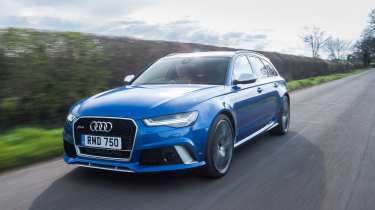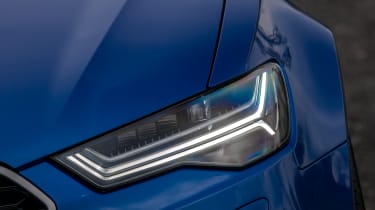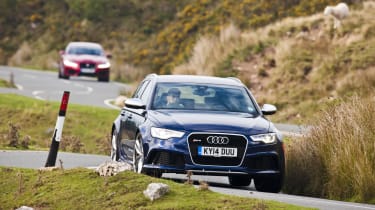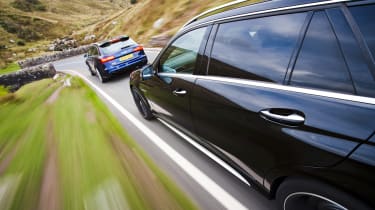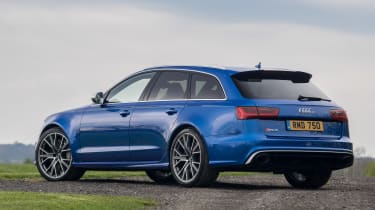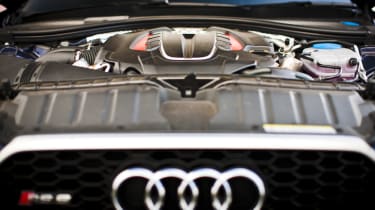Used Audi RS6 Avant (C7, 2013 - 2019) review, specs and buying guide – family-friendly supercar slayer from £20k
Audi’s C7-generation RS6 may lack ultimate involvement, but it’s still a crushingly effective and desirable super-estate
When Audi launched its RS2 Avant all the way back in 1994 it established a genre that’s been synonymous with the brand for over three decades – indecently rapid, all-wheel drive estates with attitude. BMW might have just pipped Audi to the fast estate post with its E34 M5 Touring, but it lacked the four driven wheels of the Audi and after a brief flirtation with the über-estate BMW ditched it until its second attempt with the E61 M5 Touring.
No, if you wanted a formidably fast all-weather family wagon it had to be an Audi RS6 or RS4, with which it more or less cornered the market. And one of the best was the C7 generation of RS6. A practical five-door estate that could give supercars a run for their money the RS6 was a formidable all-rounder and while it might have lacked the V10 glamour of its C6 RS6 predecessor it was a much better car. Why anyone would have considered a turbo or supercharged SUV over an RS6 we have no idea.
This car may have had a smaller and marginally less powerful engine than the V10 C6, but it brought an entirely new level of performance to the table. Its then-new 4-litre TFSI twin-turbocharged V8 was lighter than the V10, had more torque, and featured the likes of active engine mounts and cylinder deactivation to make it a truly impressive offering. And while the RS6’s price was a lofty £77k when it made its debut there are now plenty of used examples on offer for considerably less than the cost of a new Astra estate.
Audi RS6 C7 in detail
When it was launched in 2013 the C7 RS6 produced 552bhp and 516lb ft of torque. While its closest competitors from BMW and Mercedes were still rear-wheel drive, the Audi continued with the all-wheel-drive approach for which the brand is known, sending its outputs through a full-time Torsen set-up for optimum traction and predictably brisk performance. BMW had recently introduced a dual-clutch transmission in its saloon-only F10 M5 (the first turbocharged V8 version), but we had no complaints with the RS6’s sharp-shifting eight-speed torque-converter automatic.
More reviews
The RS6’s engine was a remarkable collection of metals. There was no shortage of low-end shove and as the revs rose and the turbos were at full puff the V8’s inherent strength took over. There was no tailing off as the engine speeds increased either, and the linearity of its delivery was addictive.
> Audi RS6 GT 2025 review – has Audi made a BMW M5 CS rival?
The technical highlight of the RS6’s V8 was its cylinder-on-demand (COD) technology. It’s a piece of tech that Audi rolled out across many of its much smaller capacity engines and worked by shutting down the inlet and exhaust valves of cylinder numbers two, three, five and eight when engine speed dropped to a prescribed level. By switching to a four-cylinder engine the RS6 could achieve a claimed 28.8mpg on the combined cycle, impressive for a near two-tonne car.
Though the C7 was launched over a decade ago, its potent powertrain helped it achieve an impressively modern 3.9sec 0-62mph sprint in standard form. For some contemporary context, the identically powerful F10 M5 took 4.4sec. Top speed for the Audi was an electronically limited 155mph and if you opted for the Dynamic package and that increased to 174mph, or 189mph on cars equipped with the Dynamic plus package.
UK market RS6 Avants all came fitted with Audi’s air suspension as standard, but you could also specify sport steel springs, either as part of the Dynamic pack, or as an individual option. The suspension upgrade was designed to counteract roll and pitch by linking diagonally opposed dampers hydraulically.
> Audi RS6 (C6, 2008 - 2010): a V10 family car with supercar power
A central valve varied the dampers' characteristics according to steering inputs and lateral and longitudinal loads, and like the standard air suspension this set up retained Comfort, Dynamic Auto and Individual modes – the latter allowing you to select comfort, auto or dynamic settings for the engine, gearbox, steering, suspension, differential, and exhaust. The Dynamic pack was a popular option at £2600 and also included Dynamic steering. The Dynamic Plus package included the suspension and steering and added ceramic brakes for an eye-watering £11,500.
The ride was remarkably quiet for such a large car with 20-inch wheels and 30 profile tyres. It always felt tightly controlled and keyed into the surface without being fussy over every surface imperfection, but when those ridges and expansion joints got larger the tyres thudded and thumped their way over them and let you know about it in the cabin.
It was an Audi, so of course the interior was beyond question when it came to quality and fit and finish. The flat-bottom steering wheel was a bit passé and on the small side but that’s really it. The standard equipment list was extensive, with some of the highlights including xenon headlights, MMI sat-nav, heated leather seats and Audi’s phone box which boosted your mobile phone’s reception when connected to the car’s Bluetooth. You’ll also find a Bose 14-speaker stereo on the standard equipment list. Options included Night Vision Assist (£1750), a Head-Up display (£1240) and a B&O advanced sound system for £6300.
In 2015 the A6 range underwent its facelift so there were some detail changes for the RS6 too, including the addition of Matrix LED headlights. More significantly there was the introduction of the RS6 ‘Performance’ which upped power to 597bhp and trimmed the 0-62mph dash to 3.7sec. Other additions for the Performance model included a sport exhaust (an £1000 option on the standard car), seats in leather and Alcantara rather than just leather, and a set of 21-inch alloys.
What we said
‘So, what’s it like to drive? Fast. And big. Both of which you could probably have guessed. The grip it generates is quite astounding and it seems to reel in the horizon at an unhinged rate of knots, but while the experience is deeply impressive and occasionally mentally unsettling it’s not terribly interactive. You just have to try to keep up.
‘It’s fitted with Audi’s excellent Sport Differential, and you can feel it working and gently pushing the tail round if you get on the power early in a corner, but that tail feels a long way behind you and the effect isn’t as pronounced as in smaller models. The new RS6 is the first RS model to have adaptive air suspension (which will be standard on the UK models) but all the cars on the launch were equipped with the optional steel sprung ‘sports suspension plus’ setup.
‘You can delve into the MMI settings and switch the suspension between Comfort and Dynamic modes but given that the Dynamic mode felt too stiff and bumpy on essentially pristine German roads, you can guarantee it won’t work anywhere in the UK. Unless you plan on taking your RS6 Avant to trackdays…
‘If you do venture onto a track then it might be wise to fit the monstrous 420mm carbon ceramic brakes, which did a reassuringly good job of hauling speed off when we had a brief run up and down a stretch of Autobahn. And to be honest, charging down the outside lane of de-restricted motorway is exactly where the RS6 feels happiest.’ – Henry Catchpole, evo 2013
6574 miles in a C7 Audi RS6
‘Few cars are as easy to own as an Audi RS6, providing your pockets are deep enough. Big bills are part of the territory, but as long as you can afford them you’ll find this estate is an utterly effortless way of going very quickly – pretty much whatever the weather.
‘This doesn’t imbue it with an excess of evoness, of course. Indeed, during the six months with our RS6 I frequently found myself wishing that it would show more evidence that it enjoyed making faster progress – that the steering had more feel, the throttle a bit more finesse; that the car’s limits were graded in grey rather than the black and white of its chassis’ dedication to total adhesion.
‘But I’d also be lying if I didn’t admit the Audi’s no-nonsense warp-speed approach didn’t go a fair way towards winning me over as well. As a genuine, paid-for RS6 owner said to me, at the sort of trackday where everything arrives on a trailer: ‘If you’ve got one of these then you’re going to have something more interesting as well. Probably lots of more interesting somethings.’ Just as well, because the RS6 definitely isn’t a track star itself. At Bedford Autodrome the 552bhp 4-litre twin-turbo V8 felt almost as prodigious as it did on the road, but the rest of the experience stayed distant and aloof.
‘The steering never lost its artificial feel and the chassis’ enormous adhesion foiled my best attempts to play at the limit of grip. After five laps the brakes and tyres were properly cooked, with the former developing a low-speed squeak that remained throughout the car’s time with us, and a disintegrating tyre resulting in a £375 replacement.
‘On road, the RS6 was always mighty: safe and composed when you wanted to travel quickly, but also impressive when stuck at everyday speeds thanks to compliant suspension and a well-finished cabin packed with toys. As our RS6 had a previous life on Audi’s press fleet we didn’t get to spec it, and it’s fair to say that many of the extras seemed to be along for nothing more than the ride. The options I’d tick again would be the 21in alloys and the carbon styling package, which includes the ‘quattro’ branded front grille.
‘The Bang & Olufsen audio sounded brilliant, but I struggled with its £6300 price tag. Adaptive cruise was useful, but it feels wrong to be charged £2255 for something that’s standard on a mid-spec VW Golf. Depreciation was predictably steep, with a tame Audi dealer bidding just £82,000 (2014) on the RS6 as a trade-in, against the optioned new price of £101,020.
‘But other running costs were surprisingly light, with no scheduled servicing or notable faults to report. Fuel economy varied dramatically according to use. Driven gently, the big V8 was remarkably frugal and a couple of longer journeys showed the trip computer reporting over 27mpg. But enthusiastic progress sent the figure tumbling into the mid-teens.
‘The RS6’s extra width takes some getting used to, with anything less than an A-road feeling quite narrow when you face oncoming traffic. The wide flanks also seemed depressingly easy to scrape, picking up a couple of parking dings in our time together. Those vast alloys also seem to scuff easily too. Overall, I liked the RS6. It’s the sort of car you can fill with passengers and luggage and drive flat-out across Europe. But if I owned one, I’d need to have something more interesting as well.’ – Mike Duff, evo 194, April 2014
What to pay and buying guide
If you’d had a little fun with the options list back when the RS6 was new it was entirely possible to spec the rapid wagon to over £100k, but just over a decade later you can now buy an RS6 for around £20k. You’d need to be brave to jump in at the lower end of the market though as the RS6 has garnered itself a reputation for being expensive to maintain.
As with any performance car it’s probably best to avoid the cheapest examples being offered – they’ll be cheap for a reason – but raise your budget to around £30k and you’ll have a good choice of decent examples that haven’t been to the moon and back. Top whack for an RS6 is about £50k, but £40k should be enough to bag a late Performance model with some choice options and around 50k miles.
Before you take the plunge it’s worth considering which RS6 you want. Are you happy with the earlier cars with a modicum less power but still ballistic performance or are you after the Full Monty, the 597bhp Performance model? Are you happy with the standard air suspension or do you want the more driver-focused steel-sprung suspension set up incorporating Dynamic Ride Control (DRC)? 20- or 21-inch wheels? These decisions could have a bearing on your running costs.
The RS6 isn’t intrinsically unreliable but it has garnered a reputation for having high running costs, not helped by numerous YouTube videos with tales of woe about high fuel consumption and maintenance costs. So long as you do your research and expect your servicing costs to be significantly more than an A6 2.0-litre TDI then you should be fine.
While the DRC offers the best driving experience it is expensive to maintain if something goes wrong. Leaking and knocking dampers are relatively commonplace and if not attended to this can damage the central control valves which cost more than the already expensive dampers. The Performance model’s 21-inch wheels are proving less than durable with our broken-up roads and can buckle easily and while some can be straightened some will require replacement. The 20-inch items seem to be far more durable.
As well as potentially wobbly alloys the standard brakes can take a bit of a pounding and warped front discs are quite common too, often the result of hot spotting where the driver sits in traffic with their foot on the brake after having previously given the brakes a thorough workout. Also watch for potential coolant leaks from a hose at the back of the block that can become chafed by a clip that’s too close to it. A simple cure is to reposition the clip.
Given that versions of the Volkswagen Group 4.0 TFSI can now be found in everything from the Bentley Continental GT to the Lamborghini Urus, it should come as no surprise to learn that it’s a largely reliable unit. There are very few complaints about the powertrain itself, with ordinary driving scenarios giving little to worry about. However, partly due to its use of a torque-converter transmission, the C7 RS6 comes without a launch control function, so some owners use manual brake boosting for a spirited getaway.
Servicing is every 10k miles or yearly, whichever comes first, and every second year this will be an oil change and an inspection, too. Major services where the plugs are replaced come around every 40k miles with the diff oil also requiring replacement. Tyres will last 10-15k miles per set and fuel economy will probably average out at around the 20mpg mark, although 30 is achievable at moderate motorway pace thanks to the cylinder on demand technology.
Audi RS6 C7 specs
| Engine | V8, 3993cc, twin-turbo |
|---|---|
| Power | 552bhp @ 5700rpm |
| Torque | 516lb ft @ 1750rpm |
| Weight | 1950kg |
| 0-62mph | 3.9sec (claimed) |
| Top speed | 155mph (limited) |
| Price new | £76,985 (2014) |
| Price now | From £20k |
